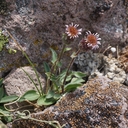Taxon Report
Erigeron nivalis Nuttallsnow fleabane daisy |
 ©2018 Matt C. Berger |
Taxon Summary
Erigeron nivalis, commonly known as snow fleabane daisy, is a perennial herb in the Asteraceae that is found in California and elsewhere. It occurs within Alpine boulder and rock field, Meadows and seeps, and Subalpine coniferous forest, growing at elevations from 1735 to 2900 meters. Erigeron nivalis is ranked 2B.3, Plants Rare, Threatened, or Endangered in California, But More Common Elsewhere; Not very threatened in California.Classification
|
Scientific Name: |
Erigeron nivalis Nuttall |
|
Common Name: |
snow fleabane daisy |
| Family: | Asteraceae |
| Element Code: | PDASTE1060 |
| USDA Plants Symbol: | |
|
Synonyms/Other Names: |
|
Ecology and Life History
| Lifeform: | perennial herb |
| Blooming Period: Jul-Aug | Jul-Aug |
| Elevation: | 1735-2900 (5695-9515) |
| General Habitats: | Alpine boulder and rock field, Meadows and seeps, Subalpine coniferous forest |
| Microhabitat: | Rocky, Volcanic |
| Microhabitat Details: |
Conservation Status
| CA Rare Plant Rank: | 2B.3 |
| Global Rank: | G5 |
|
State Rank: |
S3 |
| State List: | None |
| Fed List: | None |
| Other Status: | |
|
CRPR Changes: |
|
Occurrence Data from the CNDDB
| Total Occurrences: | 12 |
| Element Occurrence Ranks: | |
| Excellent (A) | 0 |
| Good (B) | 3 |
| Fair (C) | 0 |
| Poor (D) | 0 |
| None (X) | 0 |
| Unknown (U) | 9 |
| California Endemic: False | |
| California Counties and Islands: Name (Code) | |
| Lassen (LAS), Plumas (PLU), Shasta (SHA), Siskiyou (SIS) | |
| Quads: Name (Quad Code) | |
| Bogard Buttes (4012152), Hotlum (4112243), Lassen Peak (4012145), McCloud (4112232), Medicine Lake (4112155), Mt. Harkness (4012143), Mt. Shasta (4112242), Rainbow Mtn. (4112148), Reading Peak (4012144), West Prospect Peak (4012154) | |
Threat List Data from the CNDDB
| Threat List Total: | 1 | |
| EOs with Threat Listed: | Total EOs | % of EOs |
| 1 | 8 % | |
| Logging | 1 | 8% |
Selected References
| Erigeron nivalis profile for potential Species of Conservation Concern evaluation (2018) |
Citation
California Native Plant Society, Rare Plant Program. 2025. Rare Plant Inventory (online edition, v9.5.1). Website https://www.rareplants.cnps.org [accessed 18 December 2025].